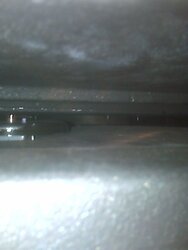I've had the insert for about 2 weeks now and have done extensive reading on this forum prior to burning so I thought I knew what I was doing. I was using an IR gun to monitor my stove top temps which I have since replaced with a Rutland thermometer. Problem was the IR gun would give me readings that varied by about 300 degrees depending upon where on top of the firebox I aimed it. So I had started a fire with the firebox pretty full of splits, had the damper wide open to get it going, check it with my IR gun and though it needed to heat up some more (was less than 500), so I sat on the couch and let it burn some more. Well I went back to check the temps with the IR gun about 10 to 15 minutes later and noticed that the outside top of firebox was glowing. I immediately shut the damper all the way and it stopped glowing within a few minutes. The fan was on high the whole time. After it cooled down I looked it over and saw no signs of damage except that the top of the firebox is now warped and is no longer flat. It sticks up a little bit in the middle maybe 1/4 inch when cold and 1/2 inch when hot. It also creaks a lot when hot (not sure if this is normal). Did I ruin my stove? I have since used it and it seems to be working just fine and much better now that I have a real thermometer.
It's very frustrating that the manual that comes with the stove has little in the way of what temps to run it at or how they recommend you burn it. Telling me I've over fired it once it's glowing does very little to help me know when it's approaching that point. No doubt it's my fault this happened but just a little frustrated they don't give you better documentation with something that can be dangerous if misused.
Anyways I've attached a pic. It's the best I could get. Please let me know if you guys think I should be concerned.
Thanks
It's very frustrating that the manual that comes with the stove has little in the way of what temps to run it at or how they recommend you burn it. Telling me I've over fired it once it's glowing does very little to help me know when it's approaching that point. No doubt it's my fault this happened but just a little frustrated they don't give you better documentation with something that can be dangerous if misused.
Anyways I've attached a pic. It's the best I could get. Please let me know if you guys think I should be concerned.
Thanks


